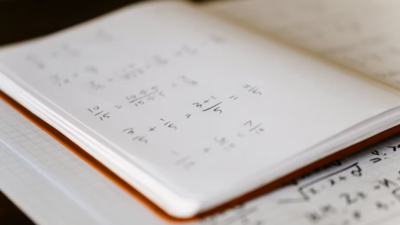ARTICLE AD BOX

Most people break out in a cold sweat when they see fractions. There's something about those little lines and numbers stacked on top of each other that makes even confident adults feel like they're back in primary school maths class, completely lost.But here's the thing about fractions: they're actually far less complicated than they appear. Once you understand the basic rules for each operation, you'll wonder why you ever found them tricky. Whether you're adding, subtracting, multiplying, or dividing, each type of calculation follows its own straightforward pattern.
Adding and subtracting fractions
The secret to successfully adding or subtracting fractions lies in one crucial concept: finding a common denominator.
Think of it like trying to combine different sized pieces of a puzzle—you need them all to be the same size before you can work with them properly.The process breaks down into these clear steps:
- Find the least common denominator: This is the smallest number that both denominators can divide into evenly. For 1/4 and 1/6, the LCD is 12.
- Adjust your fractions: Multiply each fraction to get the LCD as the new denominator. So 1/4 becomes 3/12 (multiply by 3/3) and 1/6 becomes 2/12 (multiply by 2/2).
- Add or subtract the numerators: Keep the denominator the same and work with the top numbers. For example, 3/12 + 2/12 = 5/12, or 3/12 - 2/12 = 1/12.
- Simplify if possible: Reduce your answer by dividing both numerator and denominator by any common factors. For instance, 4/12 simplifies to 1/3.
There's a helpful shortcut worth remembering: if your fractions already share the same denominator, you can skip straight to adding or subtracting the numerators. No LCD hunting required.
Multiplication
Here's where fractions become surprisingly simple.
Unlike addition and subtraction, multiplication doesn't require you to find common denominators. You can work directly with whatever fractions you're given.Here's the simple method:
- Multiply the numerators together: Take the top numbers from both fractions and multiply them.
- Multiply the denominators together: Do the same with the bottom numbers.
- Simplify your result: Look for common factors to reduce the fraction to its simplest form.
Taking 2/5 × 3/4 as an example, you'd calculate (2 × 3) for the numerator and (5 × 4) for the denominator, giving you 6/20. Since both 6 and 20 divide by 2, your final answer becomes 3/10.A useful trick for making multiplication even easier involves looking for opportunities to simplify before you multiply.
If you spot common factors between numerators and denominators across your fractions, cancel them out first. This keeps your numbers smaller and more manageable throughout the calculation.
Division through the reciprocal method
Division might seem trickier than multiplication, but there's a clever technique that makes it just as simple: multiply by the reciprocal instead.The reciprocal of a fraction is simply that fraction flipped upside down. So if you're dividing by 4/5, you'll multiply by 5/4 instead.
This transforms any division problem into a multiplication one.The method works like this:
- Flip the second fraction: Find the reciprocal of the fraction you're dividing by (turn 4/5 into 5/4).
- Change division to multiplication: Transform your division problem into multiplication using this reciprocal.
- Multiply as normal: Follow the same steps as fraction multiplication.
- Simplify your answer: Reduce the result to its simplest form if possible.
Let's walk through 2/3 ÷ 4/5. First, the reciprocal of 4/5 is 5/4. Then multiply 2/3 × 5/4, giving you 10/12. Finally, simplify to get 5/6.The key thing to remember is that you only flip the second fraction—the one you're dividing by. The first fraction stays exactly as it is.
Essential strategies for success
Several general principles can make your fraction work much smoother:
- Simplify whenever possible: Don't wait until the end—if you can reduce a fraction during your calculations, do it. Smaller numbers are always easier to work with.
- Convert improper fractions: When the numerator exceeds the denominator, consider writing it as a mixed number. For instance, 7/4 becomes much clearer as 1 3/4.
- Watch those negative signs: A fraction is negative when either the numerator or denominator is negative, but not both. This becomes particularly important during multiplication and division.
Putting it all together
Let's see these principles in action with some concrete examples.
- For adding 1/3 + 1/4, we'd find the LCD of 12, convert to 4/12 + 3/12, and get 7/12 as our answer.
- Multiplying 2/5 × 3/7 requires no common denominator work. Simply calculate (2 × 3)/(5 × 7) = 6/35.
- For division like 3/8 ÷ 2/5, we'd flip the second fraction to get 3/8 × 5/2, then multiply to get 15/16.
With these methods in your toolkit, fractions transform from obstacles into manageable mathematical tools. Practice with different combinations, and soon you'll be handling even complex fraction problems with confidence.



.png)
.png)
.png)
















 1 week ago
7
1 week ago
7









 English (US) ·
English (US) ·